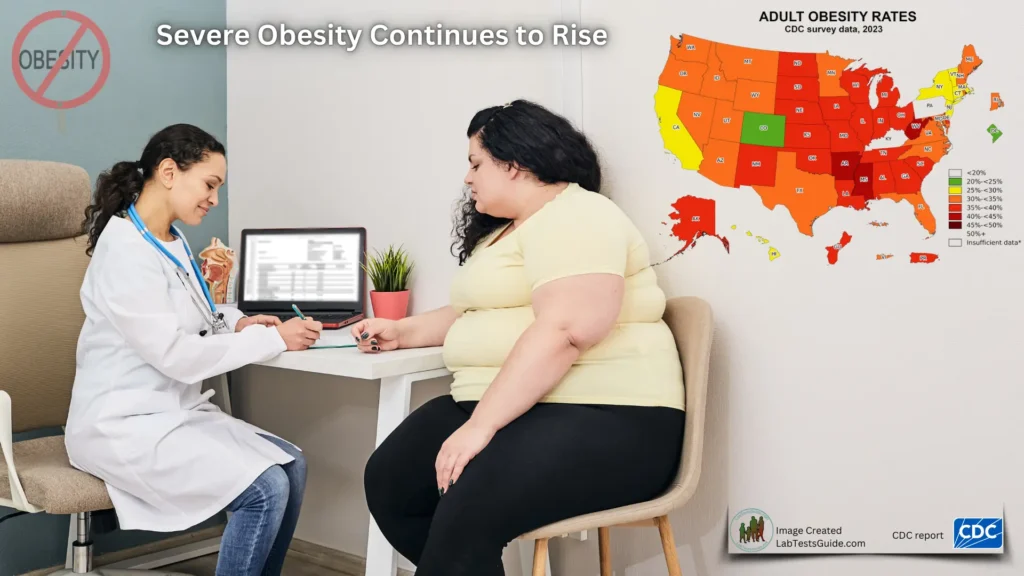While overall obesity rates in U.S. adults have plateaued at around 40%, the prevalence of severe obesity continues to increase, posing new public health challenges, according to CDC data from 2021–2023.

- Obesity Rates Plateau in U.S. Adults, but Severe Obesity Surges: CDC Report
- New CDC Data Shows a Rise in Severe Obesity, Despite Stabilized Obesity Rates
- U.S. Obesity Rate Stalls for First Time in a Decade, Severe Cases Escalate
- Severe Obesity Among U.S. Adults Continues to Climb, Says CDC
Obesity Rates in the U.S. Stabilize, but Severe Obesity Continues to Rise: CDC Report
The Centers for Disease Control and Prevention (CDC) has released new data revealing that while the overall obesity rate among U.S. adults has plateaued for the first time in over a decade, the prevalence of severe obesity continues to climb. According to the CDC’s National Center for Health Statistics, obesity rates have hovered around 40.3% between August 2021 and August 2023, a slight decline from 41.9% in 2020.
However, the most concerning finding is the rise in severe obesity, defined as having a body mass index (BMI) of 40 or higher. The data shows that the percentage of U.S. adults with severe obesity increased from 7.7% in 2013 to 9.7% in 2023. Women, in particular, were disproportionately affected, with a severe obesity rate of 12.1%, nearly double that of men at 6.7%.
Dr. Karen Hacker, Director of the CDC’s National Center for Chronic Disease Prevention, emphasized the need for preventive strategies: “This new data highlights the need for more accessible obesity prevention and treatment options. Building healthier communities where nutritious food is affordable and physical activity is accessible is essential.”
Why is Severe Obesity on the Rise?
While obesity has remained steady, the increasing rates of severe obesity raise alarming concerns. Experts suggest that metabolic, hormonal, and lifestyle factors may play significant roles, particularly for women. Some studies have indicated that the impact of childbearing and hormonal fluctuations may contribute to the disparities seen between genders.
Moreover, despite public health campaigns encouraging healthier diets and increased physical activity, societal barriers such as economic disparities and food deserts continue to make it difficult for many Americans to maintain healthy habits. Individuals in lower-income areas tend to have higher obesity rates, with almost 45% of adults without a college degree classified as obese compared to 32% of those with a higher education.
Public Health Implications
Severe obesity is closely linked to various life-threatening conditions such as heart disease, type 2 diabetes, and certain cancers. The National Institutes of Health (NIH) warns that adults with severe obesity face higher risks for these diseases, adding urgency to tackling this growing issue.
The CDC has set an ambitious target through its “Healthy People 2030” initiative, aiming to reduce the national obesity rate to 38.6%. However, the rising trend in severe obesity is making this goal harder to achieve.
Opinion: The Challenge Ahead
Although there is relief in seeing the obesity rate no longer rising, this news is tempered by the continuing growth of severe obesity. The increasing availability of weight-loss medications such as Wegovy and Zepbound offers some hope for managing the crisis. However, experts stress that medication alone cannot replace the need for systemic change in addressing food access, education, and physical activity opportunities.
Dr. Solveig Cunningham of Emory University adds, “Reversing obesity, particularly severe obesity, is difficult on both individual and population levels. While innovative treatments are valuable, we must prioritize prevention, starting from early childhood.”
As the CDC data shows, the obesity crisis remains a significant public health issue, with severe obesity emerging as an even more pressing concern. Addressing it will require comprehensive efforts that focus on prevention, treatment, and building a healthier environment for all Americans.
Additional Opinions:
- Expert Insight: “While the slight drop in obesity rates is encouraging, the continued rise in severe obesity presents a major challenge,” says Dr. Samuel Emmerich from the CDC. “We need to focus on preventing severe cases through early intervention.”
- Public Health Expert Perspective: Dr. Solveig Cunningham adds, “Focusing on lifestyle changes and community-level interventions is key to reducing both obesity and severe obesity rates. Access to affordable, nutritious food and safe environments for physical activity are critical.”
References:
- Obesity rates in US not growing for first time in a decade, but there might be a worse problem: CDC – New York Post– (Accessed on Sep 25, 2024)
- Obesity rate in U.S. adults no longer growing, new CDC data suggests – CBS News – (Accessed on Sep 25, 2024)
- Obesity rates in US not growing for first time in a decade, but severe obesity on the rise: CDC – Fox News – (Accessed on Sep 25, 2024)
- Severe obesity is on the rise in the US – AP News – (Accessed on Sep 25, 2024)
Possible References Used






